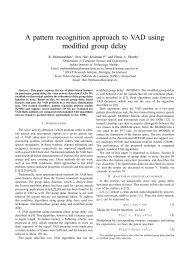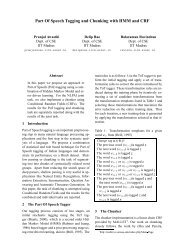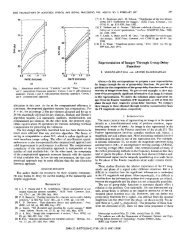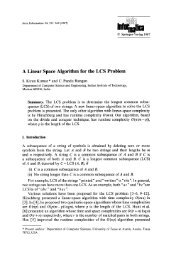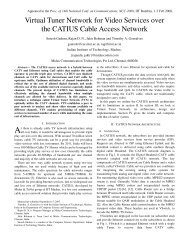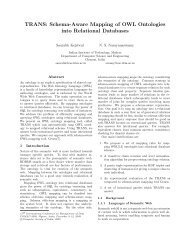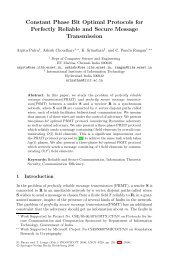On Byzantine Agreement over (2,3)-Uniform ... - Cornell University
On Byzantine Agreement over (2,3)-Uniform ... - Cornell University
On Byzantine Agreement over (2,3)-Uniform ... - Cornell University
You also want an ePaper? Increase the reach of your titles
YUMPU automatically turns print PDFs into web optimized ePapers that Google loves.
<strong>On</strong> <strong>Byzantine</strong> <strong>Agreement</strong> <strong>over</strong> (2, 3)-<strong>Uniform</strong> Hypergraphs 451<br />
agree on a value and the following conditions hold: (1) <strong>Agreement</strong>: All honest<br />
processes agree on the same value; (2) Validity: If all honest processes start with<br />
the value v ∈{0, 1}, then all honest processes agree on v; (3)Termination: All<br />
honest processes eventually agree.<br />
In this paper, we shall use the simple and standard model of a synchronous<br />
network wherein any communication protocol evolves as a series of rounds, during<br />
which the players send messages, receive them and perform (polynomial<br />
time) local computations according to the protocol.<br />
The processes’ mutual distrust in the network is typically modeled via a<br />
(fictitious) centralized adversary that is assumed to control/corrupt the faulty<br />
processes. In the threshold adversary model, a fixed upper bound t is set for the<br />
number of faulty processes.<br />
Over a complete graph (of point-to-point authenticated channels), it was<br />
proved [11] that, <strong>Byzantine</strong> agreement is achievable on a set of n processes<br />
with t (<strong>Byzantine</strong>) faults if and only if t< n 3<br />
. Subsequently, there have been<br />
(successful) attempts on “improving” the above bound.<br />
<strong>On</strong>e approach has been to study the problem in a non-threshold adversary<br />
model like in [8, 6, 1]. In this model the adversary is characterized by an adversary<br />
structure which is a monotone set of subsets of processes from which processes<br />
in any one of the subsets may be corrupted; it was proved [6] that <strong>Byzantine</strong><br />
agreement is possible if and only if the adversary structure A adv satisfies Q (3) ,<br />
i.e., no three sets in A adv c<strong>over</strong> the full set of processes.<br />
A second approach is to assume (stronger) communication primitives in addition<br />
to the point-to-point authenticated links. For example in [7], a broadcast<br />
among three processes was assumed to be available among every set of three<br />
processes and the bound was improved to t< n 2 .<br />
In another line of research, Dolev et. al. in [5] study the possibility of <strong>Byzantine</strong><br />
agreement <strong>over</strong> incomplete graphs. If n>3t, theyprovethat<strong>Byzantine</strong><br />
agreement is achievable if and only if the underlying graph is at least (2t +1)-<br />
connected. Generalizing this result using the first approach, Kumar et. al. [9]<br />
show that if the adversary structure A satisfies Q (3) , <strong>Byzantine</strong> agreement is<br />
achievable if and only if the underlying graph is A (2) -connected, that is, the<br />
union of no two sets in the adversary structure is a vertex cut-set of the graph.<br />
With this as the state-of-the-art, the following question (mentioned as an<br />
open problem in [7]) arises: what is a necessary and sufficient condition for<br />
achieving <strong>Byzantine</strong> agreement <strong>over</strong> incomplete (2, 3)-uniform hypergraphs? In<br />
this paper, we provide a concise characterization that generalizes the results of<br />
[5] (which uses the 1-cast model) to the (2, 3)-uniform hypergraph model.<br />
2 Motivation and Contributions<br />
In practice one finds local broadcast channels in various networks in the form<br />
of LAN (Local Area Network) like an Ethernet or Token ring system. Another<br />
example is wireless communication, which is inherently broadcast in nature. A<br />
particular case when there is a local broadcast among every three players, that



